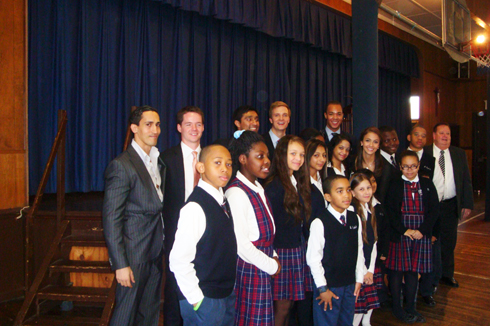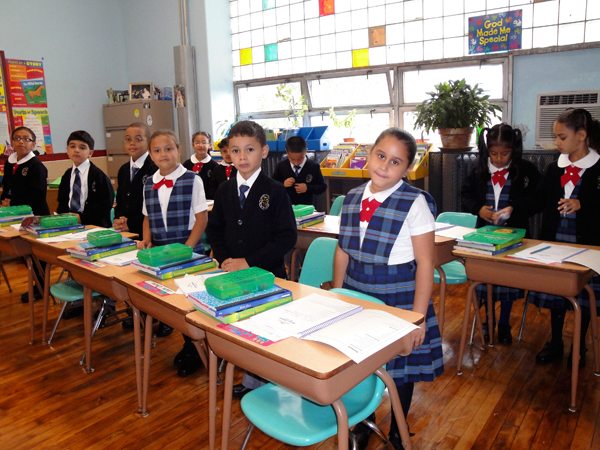by Gail Donovan
This is the fourth in a series of articles about the future of Catholic schools in Brooklyn and Queens.

Spend a few minutes talking to Joe Sawe and you will easily get caught up in his energetic vision for Catholic education in Brooklyn and Queens.
Sawe, who is an alumnus of St. Elizabeth School in Ozone Park, wanted to give back to the institution that prepared him for his current career at UBS, so he joined the Advisory Board of his alma mater and when the school became an academy in 2011, agreed to serve as chairman of its board.
Sawe was so impressed with the academy model that he began recruiting other young professionals at UBS and beyond to serve on the boards of academies in the Diocese of Brooklyn. He also created and is introducing to the academies a nonprofit organization called Project Empower, which fosters leadership in young people and gives them effective guidance to visualize career goals and foster social entrepreneurship.
When Project Empower was announced in November, Bishop Frank Caggiano, Vicar General, said it exemplifies the goals set forth in the diocesan program, Preserving the Vision, to create multiple partnerships designed to strengthen Catholic education.
“This unique initiative brings together corporations, universities, both Catholic and non-Catholic, to benefit children who are attending our Catholic schools,” said Bishop Caggiano.
“We want to give the students the tools they need to choose a career they are passionate about,” Sawe said. “By bringing in outside partnerships with universities and businesses, students can understand the choices that will be available to them later in life after they graduate.”
Tuition-Free in Bushwick
Another goal of Preserving the Vision is increasing development efforts in schools and academies to realize at least 30% of operating revenue from advancement efforts by 2017. An example of what’s possible is Pope John Paul II Family Academy, located in the former St. Barbara’s School, Bushwick, which is 100% funded by outside sources. The academy was founded in 2009 by an anonymous benefactor who was a product of Catholic schools in the Diocese of Brooklyn.
John Viola, director of Pope John Paul II Family Academy, said the school has implemented a business model and is seeking additional funds from other private sources.
“The best way to encourage people to participate is to show them clearly where the funds are going,” Viola said. “We know from our work in the private sector how to keep student costs low and that financial responsibility is important. Everything we’ve done in the school has been around economic responsibility.”
The academy is tuition-free but to be accepted students and their families must be practicing Catholics and live within walking distance of the school. The current enrollment is 152 students from Pre-K through fourth grade, and additional grades will be added as the older students move up.

The academy works because it unites education and faith to develop the whole person, Viola said. “The only thing we ask in return is for families to live their religious faith.”
Viola said creating Pope John Paul II Family Academy has required out of the box thinking. The hope is to replicate the academy’s model and create other tuition-free Catholic schools in Brooklyn and Queens.
In keeping with the goal of fiscal responsibility, Preserving the Vision requires schools and academies to develop and/or regularly update their strategic plans.
“Strategic plans are important for academies because they allow for a roadmap or blueprint for three to five years with specific goals and objectives,” said Thomas Chadzutko, Superintendent of Schools – Catholic School Support Services, whose department will be helping schools and academies prepare their strategic plans.
“Without a strategic plan, you’re just going year to year without any specific objectives.”
Under Preserving the Vision, each school and academy is charged with increasing K-eight enrollment by 10% each year. To reach that goal, schools and academies must develop and execute an enrollment management and marketing plan with specific strategies and tactics for promotion, marketing, recruitment, and retention.
Many schools and academies are increasing enrollment from the ground up by beefing up their Pre-K programs; adding classes for three-year-olds and offering Universal Pre-K for four-year-olds. Universal Pre-K is government-funded and, as a result, offers a half-day program to children for free, while the families of children who elect to stay for the full day pay for the second half day.
Diocesan statistics show that at least 50% of the children who attend a Catholic pre-school go on to attend kindergarten in the same building.
A marketing team from the Superintendent of Schools – Catholic School Support Services is helping schools and academies prepare brochures, direct mail campaigns, and other marketing materials to increase awareness and attract new students.
“It’s essential that schools and academies brand for educational excellence and Catholic identity and share with their target market the excellent 21st Century technology, education, and learning they provide,” said George Maggiore, who is part of the Superintendent’s marketing team and serves as co-chair of the Preserving the Vision Advisory Committee’s Marketing, Recruitment, and Retention Subcommittee.
A full copy of Preserving the Vision Strategic Plan 2011-2014 is available at mybqcatholicschool.com.
